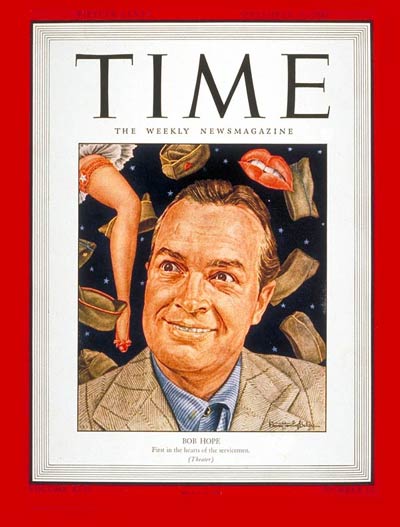
In this week’s issue of TIME, Richard Zoglin takes a look at how the legendary performer Bob Hope paved the way for the activists of modern Hollywood. As Zoglin — the author of a new book about the comedian, Hope: Entertainer of the Century — points outs, Hope was just one of many celebrities who kept World War II morale high with USO tours, but he managed to establish a lasting connection between his career and the armed forces.
Which would not surprise anyone who read TIME’s Sept. 20, 1943, cover story about Bob Hope. As that article recounts, the entertainer was so devoted to the cause that at one point, when it looked like his tour might not happen, he wired a Lieutenant General directly: “WE SING, DANCE, TELL STORIES; HAVE TUXEDOS; WILL TRAVEL; CAN WE PLAY YOUR CIRCUIT?”
And the audiences were nothing if not appreciative of the effort:
For fighting men, this grimmest of wars is in one small way also the gayest. Never before have the folks who entertain the boys been so numerous or so notable; never have they worked so hard, traveled so far, risked so much. In the Middle East last week were Jack Benny, Larry Adler with his harmonica, Al Jolson with a harmonium; Ray Bolger was in the South Pacific, Judith Anderson in Hawaii. A while back Martha Raye went to the foxholes of Tunisia; and in New Guinea a show went on within earshot of the Japs. From the ranks of show business have sprung heroes and even martyrs, but so far only one legend.
That legend is Bob Hope. It sprang up swiftly, telepathically, among U.S. servicemen in Britain this summer, traveling faster than even whirlwind Hope himself, then flew ahead of him to North Africa and Sicily, growing larger as it went. Like most legends, it represents measurable qualities in a kind of mystical blend. Hope was funny, treating hordes of soldiers to roars of laughter. He was friendly—ate with servicemen, drank with them, read their doggerel, listened to their songs. He was indefatigable, running himself ragged with five, six, seven shows a day. He was figurative—the straight link with home, the radio voice that for years had filled the living room and that in foreign parts called up its image. Hence boys whom Hope might entertain for an hour awaited him for weeks. And when he came, anonymous guys who had had no other recognition felt personally remembered.
Read the full 1943 cover story here, in TIME’s archives: Hope for Humanity
LIFE with Bob Hope: Classic Photos of an American Wisecracker
More Must-Reads From TIME
- The 100 Most Influential People of 2024
- Coco Gauff Is Playing for Herself Now
- Scenes From Pro-Palestinian Encampments Across U.S. Universities
- 6 Compliments That Land Every Time
- If You're Dating Right Now , You're Brave: Column
- The AI That Could Heal a Divided Internet
- Fallout Is a Brilliant Model for the Future of Video Game Adaptations
- Want Weekly Recs on What to Watch, Read, and More? Sign Up for Worth Your Time
Write to Lily Rothman at lily.rothman@time.com